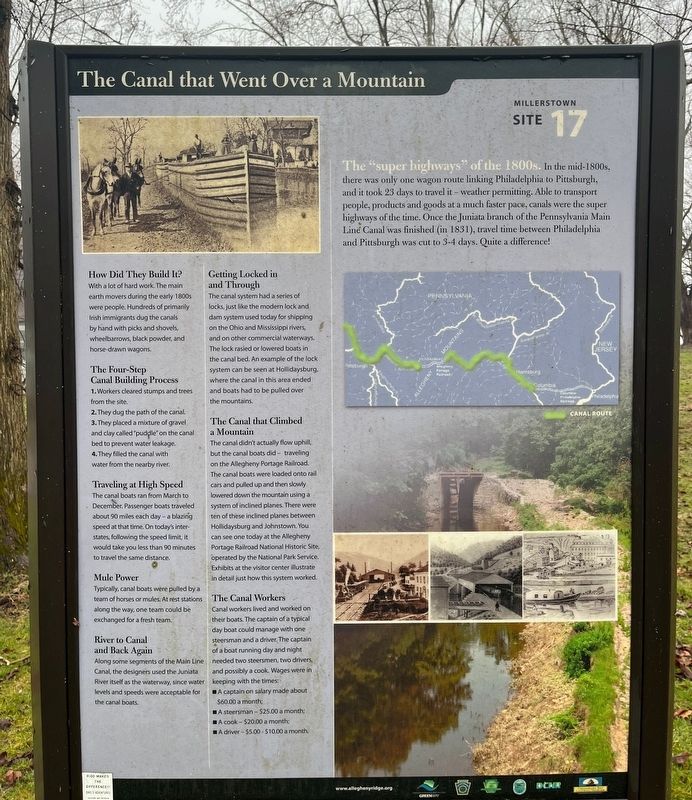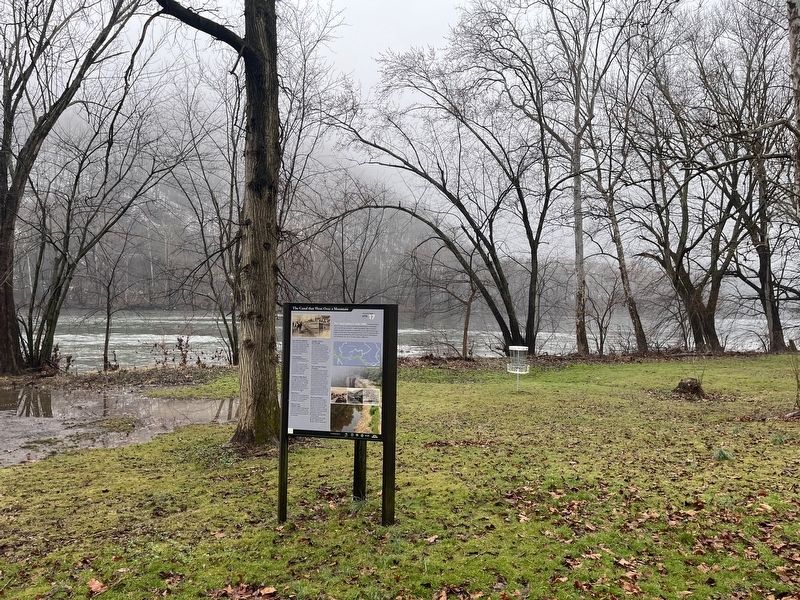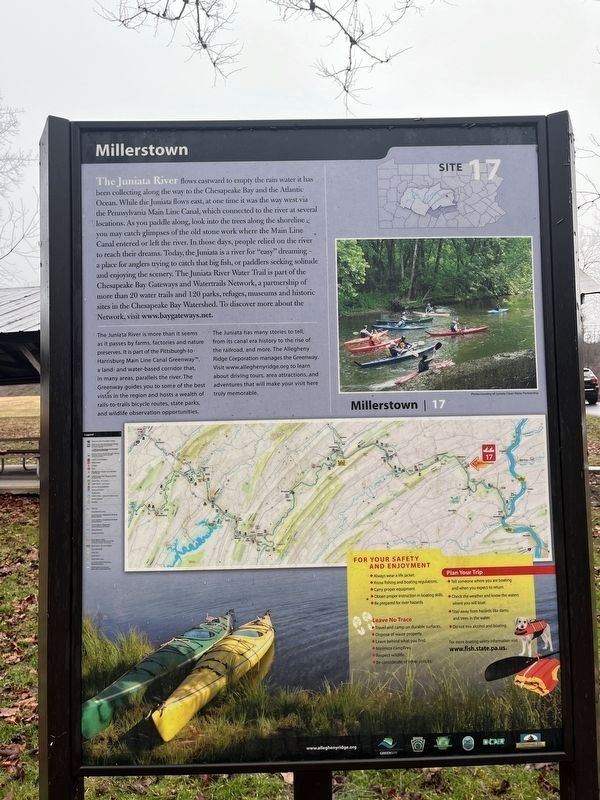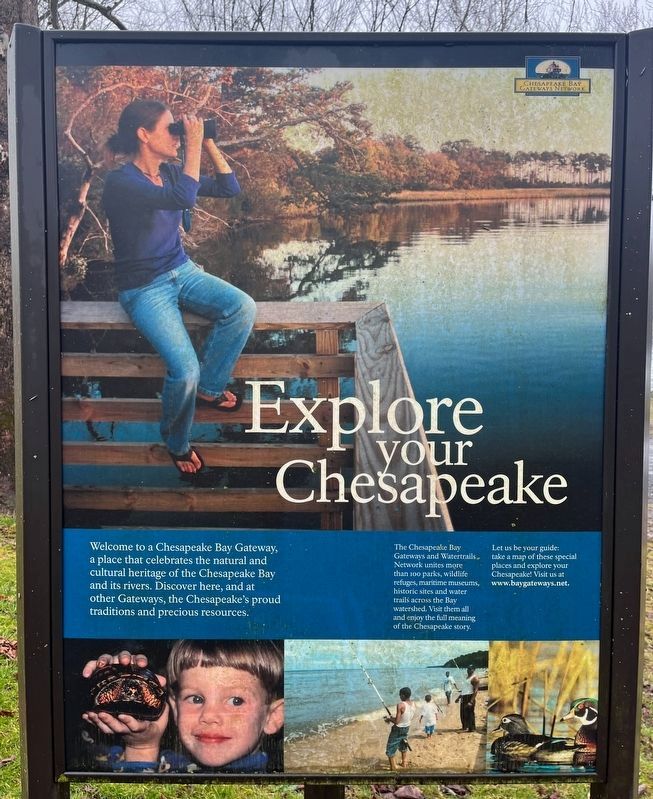Greenwood Township near Millerstown in Perry County, Pennsylvania — The American Northeast (Mid-Atlantic)
The Canal that Went Over a Mountain
Millerstown

Photographed By Devry Becker Jones (CC0), February 23, 2024
1. The Canal that Went Over a Mountain Marker
The "super highways" of the 1800s. In the mid-1800s, there was only one wagon route linking Philadelphia to Pittsburgh, and it took 23 days to travel it weather permitting. Able to transport people, products and goods at a much faster pace, canals were the super highways of the time. Once the Juniata branch of the Pennsylvania Main Line Canal was finished (in 1831), travel time between Philadelphia and Pittsburgh was cut to 3-4 days. Quite a difference!
How Did They Build It?
With a lot of work. The main earth movers during the early 1800s were people. Hundreds of primarily Irish immigrants dug the canals by hand with picks and shovels, wheelbarrows, black powder, and horse-drawn wagons.
The Four-Step Canal Building Process
1. Workers cleared stumps and trees from the site.
2. They dug the path of the canal.
3. They placed a mixture of gravel and clay called "puddle" on the canal bed to prevent water leakage.
4. They filled the canal with water from the nearby river.
Traveling at High Speed
The canal boats ran from March to December. Passenger boats traveled about 90 miles each day a blazing speed at that time. On today's interstates, following the speed limit, it would take you less than 90 minutes to travel the same distance.
Mule Power
Typically, canal boats were pulled by a team of horses or mules. At rest stations along the way, one team could be exchanged for a fresh team.
River to Canal and Back Again
Along some segments of the Main Line Canal, the designers used the Juniata River itself as the waterway, since water levels and speeds were acceptable for the canal boats.
Getting Locked in and Through
The canal system had a series of locks, just like the modern lock and dam system used today for shipping on the Ohio and Mississippi Rivers, and on other commercial waterways. The lock raised or lowered boats in the canal bed. An example of the lock system can be seen at Hollidaysburg, where the canal in this area ended and boats had to be pulled over the mountains.
The Canal that Climbed a Mountain
The canal didn't actually flow uphill, but the canal boats did traveling on the Allegheny Portage Road. The canal boats were loaded onto rail cars and pulled up then slowly lowered down the mountain using a system of inclined planes. There were ten of these inclined planes between Hollidaysburg and Johnstown. You can see one today at the Allegheny Portage Railroad National Historic Site, operated by the National Park Service. Exhibits at the visitor center illustrate in detail

Photographed By Devry Becker Jones (CC0), February 23, 2024
2. The Canal that Went Over a Mountain Marker on the grounds of Millerstown Area Community Park
The Canal Workers
Canal Workers lived and worked on their boats. The captain of a typical day boat could manage with one steersman and a driver. The captain of a boat running day and night needed two steersmen, two drivers, and possibly a cook. Wages were in keeping with the times:
A captain on salary made about $60.00 a month;
A steersman $25.00 a month;
A cook $20.00 a month;
A driver $5.00 - $10.00 a month.
Erected by DCNR; Chesapeake Bay Gateways Network. (Marker Number 17.)
Topics. This historical marker is listed in these topic lists: Animals • Industry & Commerce • Natural Features • Waterways & Vessels. A significant historical year for this entry is 1813.
Location. 40° 32.435′ N, 77° 8.997′ W. Marker is near Millerstown, Pennsylvania, in Perry County. It is in Greenwood Township. Marker can be reached from the intersection of West Juniata Parkway (County Road 1015) and U.S. 22/322, on the right when traveling south. The marker stands on the grounds of Millerstown Area Community Park. Touch for map. Marker is at or near this postal address: 100 W Juniata Pkwy, Millerstown PA 17062, United States of America. Touch for directions.
Other nearby markers. At least 8 other markers are within walking distance of this marker. Millerstown Dairies (within shouting distance of this marker); Millerstown Recreation

Photographed By Devry Becker Jones (CC0), February 23, 2024
3. The Juniata River Water Trail signage that is part of the display

Photographed By Devry Becker Jones (CC0), February 23, 2024
4. Explore Your Chesapeake signage
This sign is part of the display as well.
Credits. This page was last revised on February 25, 2024. It was originally submitted on February 25, 2024, by Devry Becker Jones of Washington, District of Columbia. This page has been viewed 46 times since then. Photos: 1, 2, 3, 4. submitted on February 25, 2024, by Devry Becker Jones of Washington, District of Columbia.